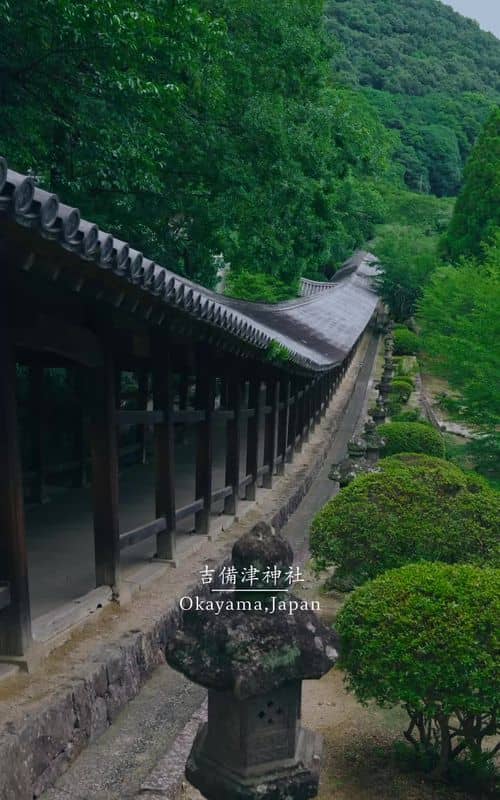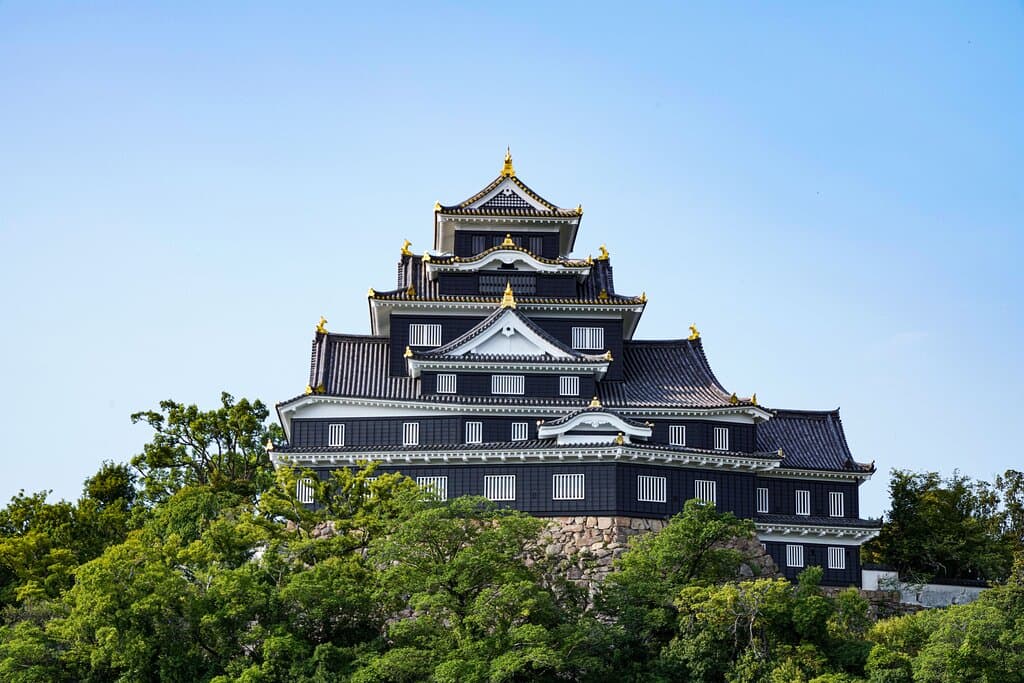
Kibitsu Shrine
A serene national treasure, Kibitsu Shrine boasts unique Kibitsu-zukuri architecture and is the legendary birthplace of Momotaro.
Highlights
Must-see attractions

Social
From TikTok & Reddit
Best Time
Beautiful cherry blossoms or fall foliage

Kibitsu Shrine
Best Time
Beautiful cherry blossoms or fall foliage
Highlights
Must-see attractions
A serene national treasure, Kibitsu Shrine boasts unique Kibitsu-zukuri architecture and is the legendary birthplace of Momotaro.
"Unlike the famous shrines in Kyoto that are always packed with people, this one is peaceful."
🚶♀️ Peaceful Exploration
Enjoy the serene atmosphere; it's much less crowded than major city shrines. :pray:
🌸 Seasonal Beauty
Visit in spring for cherry blossoms or autumn for vibrant foliage. :maple_leaf:
Highlights
Discover the most iconic attractions and experiences
Kibitsu-zukuri Architecture
Main Hall
Witness Japan's sole example of this unique double-gabled roof style, a truly distinctive architectural marvel.
The 360m Corridor
Path leading to the shrine
Stroll through a long, elegant, and scenic corridor, offering a serene and picturesque journey.
Momotaro Legend Connection
Shrine grounds
Explore the birthplace of the beloved Momotaro fairytale, where history and myth intertwine.
Dohyō (Sumo Ring)
Shrine grounds
See the ancient sumo wrestling ring, a testament to the sport's spiritual origins and ceremonies.
Plans like a pro.
Thinks like you
Planning Your Visit
Embrace the Tranquility
Uncover the Legend
Best Times
Insider Tips
from TikTok, Instagram & Reddit
🚶♀️ Peaceful Exploration
Enjoy the serene atmosphere; it's much less crowded than major city shrines. :pray:
🌸 Seasonal Beauty
Visit in spring for cherry blossoms or autumn for vibrant foliage. :maple_leaf:
🅿️ Convenient Parking
Ample free parking is available on-site. :car:
🆓 Free Entry
Admission to the shrine grounds is free. :moneywithwings:
Tips
from all over the internet
🚶♀️ Peaceful Exploration
Enjoy the serene atmosphere; it's much less crowded than major city shrines. :pray:
🌸 Seasonal Beauty
Visit in spring for cherry blossoms or autumn for vibrant foliage. :maple_leaf:
🅿️ Convenient Parking
Ample free parking is available on-site. :car:
🆓 Free Entry
Admission to the shrine grounds is free. :moneywithwings:
👟 Comfortable Shoes
You'll be doing a fair bit of walking, especially on the long corridor. :athletic_shoe:
What Travellers Say
Reviews Summary
Visitors praise Kibitsu Shrine for its peaceful atmosphere, unique Kibitsu-zukuri architecture, and its deep connection to the Momotaro legend. It's highlighted as a serene escape from crowded tourist spots, offering a chance to appreciate history and folklore in a tranquil setting. Some note the beauty of the long corridor and the historical sumo ring.
"One of the best parts of cycling the Kibiji bike trail is finding this amazing old shrine. It's a truly quiet and special place. Unlike the famous shrines in Kyoto that are always packed with people, this one is peaceful. You can walk around the grounds without being in a huge crowd, which is a wonderful and relaxing change. You can feel a real sense of calm here, and it's the kind of place where you can finally hear yourself think and just enjoy the beautiful nature and historic buildings around you.
But this shrine has a secret: it’s connected to a very famous story. You might know the legend of Momotaro, the "Peach Boy" who came from a giant peach to fight monsters. Many people in Japan believe that this beloved fairytale actually started right here. The legend is based on a real prince who is honored at this shrine, and as you walk around the ancient grounds, you can almost imagine his epic adventures happening long ago.
What really surprised me was finding a dohyō—a sumo wrestling ring—on the shrine grounds. It’s a raised circle made of packed clay and sand, and seeing it makes history feel so real. This ring is solid proof of how the sport of sumo began. Long ago, sumo wasn't just a sport; it was a special ceremony. Matches were held right here to honor the gods and ask for a good harvest.
Kibitsu Jinja is an incredible stop where you get to enjoy a quiet escape, walk through the setting of a famous legend, and see the spiritual home of sumo wrestling all in one visit."
Kee Haur Ng
"A sacred landmark which is quiet & free from disturbances. It’s ancient & traditional architectural style, double gabled roof makes a must see spot. It’s one of major shrine in Japan.
Parking: plenty of free parking available.
Entry fee: free"
吉岡
"Kibitsu Shrine is a breathtakingly grand shrine, one of the largest I’ve seen in Japan! Just a 25-minute walk from Kibitsu Hiko Shrine, it’s well worth the visit. The striking entrance, adorned with beautiful white lanterns, is truly captivating. The long, elegant corridor running alongside the shrine adds to its majestic charm. A must-see for anyone seeking a serene and awe-inspiring cultural experience!"
Michael Hui
What People Like
What People Dislike
Frequently Asked Questions
🚇 🗺️ Getting There
From Okayama Station, you can take the JR Kibi Line to Kibitsu Station, which is about a 25-minute walk to the shrine. Alternatively, a taxi from Okayama Station will take approximately 20-30 minutes. Some visitors also cycle the Kibiji bike trail, which passes by the shrine.
Yes, Kibitsu Shrine is accessible by public transport. The nearest train station is Kibitsu Station on the JR Kibi Line. From there, it's a pleasant walk to the shrine.
Many visitors enjoy cycling the Kibiji bike trail, which connects several historical sites in the region, including Kibitsu Shrine. This offers a scenic and immersive way to experience the local landscape.
Yes, there is plenty of free parking available at Kibitsu Shrine, making it convenient for those arriving by car.
Absolutely! Kibitsu Shrine is a popular stop on day trips from Okayama city and can be easily incorporated into a wider itinerary of the region.
🎫 🎫 Tickets & Entry
No, entry to the grounds of Kibitsu Shrine is free of charge. You can explore the main areas and enjoy the architecture without any admission fee.
Kibitsu Shrine is generally open year-round, with no strict closing hours for the outdoor grounds. However, specific building access might vary. It's best to check for any seasonal changes if you plan to visit specific inner areas.
While not explicitly mentioned in the provided content, major shrines often host seasonal festivals. It's advisable to check the official shrine calendar closer to your visit for any special events.
The main shrine grounds are free to enter. Information regarding fees for specific inner buildings or exhibitions is not detailed, but typically, access to the main worship areas is free.
Most major shrines in Japan offer a selection of omamori (amulets), ema (votive tablets), and other traditional souvenirs. It's likely Kibitsu Shrine also has a shop for these items.
📸 📸 Photography
Photography is generally allowed in most outdoor areas of Kibitsu Shrine, allowing you to capture its unique architecture and serene atmosphere. However, always be respectful and check for any signs prohibiting photos inside specific buildings.
The 360-meter long corridor, the distinctive Kibitsu-zukuri architecture of the main hall, and the striking entrance with white lanterns are highly photogenic. The surrounding nature also offers beautiful shots, especially during spring and autumn.
Drone usage is typically restricted at religious sites and historical landmarks in Japan to ensure the peace and safety of visitors. It's best to assume drones are not permitted unless explicitly stated otherwise.
Early morning or late afternoon can offer beautiful lighting conditions with fewer crowds, creating a more atmospheric and photogenic experience. The interplay of light and shadow in the long corridor is particularly striking.
Yes, the dohyō (sumo ring) is an interesting historical feature and can be photographed as part of your exploration of the shrine grounds.
🎫 🌳 Onsite Experience
Kibitsu Shrine is significant as the spiritual home of the Momotaro legend and is a prime example of the unique Kibitsu-zukuri architectural style. It also holds historical importance related to sumo wrestling.
Kibitsu-zukuri is a rare architectural style characterized by its double-gabled roof, giving the main hall a distinctive twin-like appearance. Kibitsu Shrine is the only known example of this style.
Yes, there is a pond with koi fish, and visitors are often able to feed them, adding a pleasant interactive element to the visit.
The shrine grounds include manicured gardens, which are beautiful throughout the year, especially when adorned with seasonal flowers like hydrangeas in June.
The Momotaro legend is a famous Japanese folktale about a boy born from a giant peach who grows up to fight ogres and bring peace. Kibitsu Shrine is believed to be the origin of this story.
For Different Travelers
Tailored advice for your travel style
👨👩👧 Families with Kids
While the shrine is serene, the open grounds allow children to explore without feeling overly restricted. It's a great opportunity to introduce them to Japanese culture, history, and folklore in a calm environment, a welcome contrast to more crowded tourist spots. Remember to bring comfortable shoes for everyone, as there's a good amount of walking involved.
🚶 Solo Travelers & Peace Seekers
It's a place where you can hear yourself think and appreciate the beauty of Japanese nature and traditional design at your own pace. The free entry and ample parking also make it an accessible and stress-free option for independent exploration.
📸 Photographers & Culture Enthusiasts
Beyond the structures, the seasonal beauty of the gardens, the dohyō (sumo ring), and the overall serene ambiance make for a rich photographic experience. The shrine's connection to the Momotaro legend adds a layer of cultural depth that is fascinating to explore and capture.
Deep Dives
In-depth insights and expert knowledge
The Architectural Marvel: Kibitsu-zukuri
The 360-meter long corridor that runs alongside the shrine is another architectural highlight. Its elegant curves and the play of light and shadow create a mesmerizing and tranquil pathway for visitors. This corridor not only adds to the aesthetic beauty of the shrine but also provides a sense of journey and contemplation as you walk through it. The visual impact of this extended walkway is frequently highlighted in social media content, emphasizing its serene and picturesque quality.
Beyond the main structures, the shrine complex is dotted with pagodas, smaller dedicatory shrines, and beautifully manicured gardens. These elements contribute to the overall peaceful and spiritual ambiance of Kibitsu Shrine. The presence of a pond with koi fish, which visitors can feed, adds an interactive and charming dimension to the experience, further enhancing its appeal as a place of natural beauty and cultural heritage.
Momotaro: The Legend and the Shrine
The connection to Momotaro transforms a visit to Kibitsu Shrine into an immersive cultural experience. It's not just about admiring architecture; it's about stepping into a piece of living folklore. This aspect is frequently mentioned by visitors who find the shrine to be a place where history and myth converge, offering a unique glimpse into Japanese storytelling traditions.
Beyond Momotaro, the shrine also holds historical significance related to sumo wrestling. A dohyō, or sumo ring, can be found on the grounds, serving as a reminder of sumo's origins as a ritualistic ceremony to honor the gods and pray for good harvests. Seeing this ancient ring makes the history of the sport feel tangible and connects the shrine to another important aspect of Japanese culture.






Social
from TikTok, Instagram & Reddit